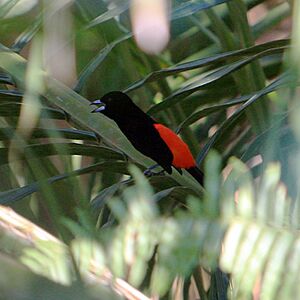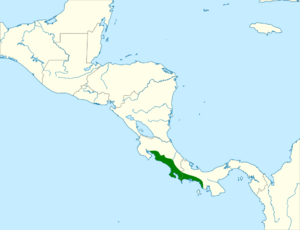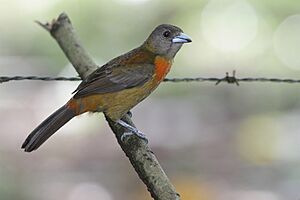Cherrie's tanager facts for kids
Quick facts for kids Cherrie's tanager |
|
|---|---|
 |
|
| Male in Costa Rica | |
| Conservation status | |
| Scientific classification |
|
| Kingdom: | Animalia |
| Phylum: | Chordata |
| Class: | Aves |
| Order: | Passeriformes |
| Family: | Thraupidae |
| Genus: | Ramphocelus |
| Species: | |
| Subspecies: |
R. p. costaricensis
|
| Trinomial name | |
| Ramphocelus passerinii costaricensis Cherrie, 1891
|
|
 |
|
The Cherrie's Tanager (scientific name: Ramphocelus passerinii costaricensis) is a beautiful, medium-sized bird. It belongs to a group of birds called passerines, which are often known as "perching birds." You can find this tanager living in the lowlands along the Pacific coast of Costa Rica and in western Panama.
For a while, this bird was considered a separate species. It was split from another similar bird called the Scarlet-rumped Tanager. The Caribbean version of that bird was then called Passerini's Tanager. But later, scientists decided that the Cherrie's Tanager and the Scarlet-rumped Tanager were actually the same species. So, now the Cherrie's Tanager is considered a subspecies of the Scarlet-rumped Tanager.
Contents
Where Cherrie's Tanagers Live
Cherrie's Tanagers are very common birds. They live from sea level up to about 1,200 meters (around 3,900 feet) high. Sometimes, you might even spot them as high as 1,700 meters (about 5,600 feet).
Preferred Homes for Tanagers
These birds love places that are partly open. This includes areas with new, young plants growing, the edges of forests, gardens, and even pastures that have bushes. They build their nests in trees, usually about 6 meters (20 feet) off the ground.
Nests and Eggs
A female Cherrie's Tanager typically lays two eggs. These eggs are a pale blue or gray color. They often have interesting marks in black, brown, or lilac shades. Sometimes, these busy birds will even raise two sets of chicks in one season!
What Cherrie's Tanagers Look Like
An adult Cherrie's Tanager is about 16 centimeters (6.3 inches) long. It weighs around 31 grams (just over 1 ounce), which is about the same as a few quarters.
Male Tanager's Colors
The adult male Cherrie's Tanager is mostly black. But it has a bright scarlet (bright red) patch on its rump, which is the lower part of its back. Its bill (beak) is silvery, and its eyes are a dark red color.
Female Tanager's Colors
The female Cherrie's Tanager looks quite different from the male. She has a gray head and olive-colored feathers on her upper body. Her rump is orange, and her wings and tail are brownish. Her belly is a yellowish-brown color, and she has a wide orange band across her chest. The way the female looks is one of the main differences between the Cherrie's Tanager and the Passerini's Tanager.
Young Tanagers
Young Cherrie's Tanagers look a lot like the adult females. However, their orange chest band is usually not as bright.
Tanager Habits and Food
Cherrie's Tanagers can be seen in pairs or small groups. They also sometimes join larger groups of different bird species that are looking for food together. At night, up to a dozen of these birds might gather to sleep in thick, dense bushes.
What They Eat
These birds enjoy eating small fruit, which they usually swallow whole. They also like to snack on insects and spiders.
Sounds of the Cherrie's Tanager
The call of the Cherrie's Tanager is a sharp sound that sounds like "wac." When it sings, it makes a few clear, pleasant notes. Its song is usually longer than the song of its relative from the Caribbean.
Honoring George Cherrie
This bird is named Cherrie's Tanager to remember an American naturalist, explorer, and adventurer named George Kruck Cherrie. Dr. Cherrie was a very important person. He even went with former President Theodore Roosevelt on a famous trip in 1913. They explored a river in the Brazilian Amazon rainforest that was later named the Rio Roosevelt.



